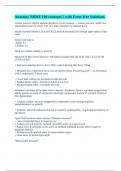Exam (elaborations)
Anatomy NBME 100 concepts || with Error-free Solutions.
- Course
- Institution
Lumbar puncture (tap) & epidural anesthesia correct answers → lumbar puncture: needle into subarachnoid space to extract CSF or to inject anesthetic to epidural space Needle inserted between L3/L4 (or L4/L5) level of horizontal line through upper points of iliac crests Spinal cord ends in: ...
[Show more]



